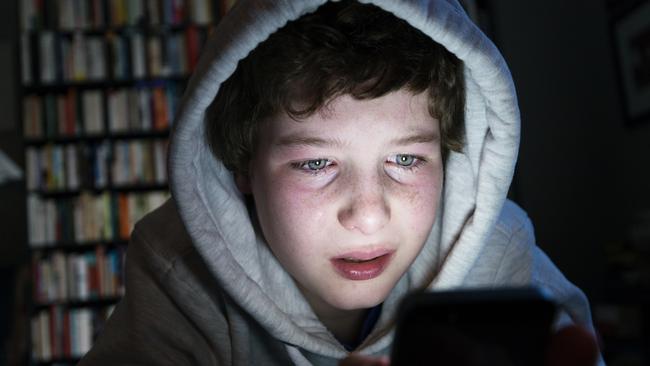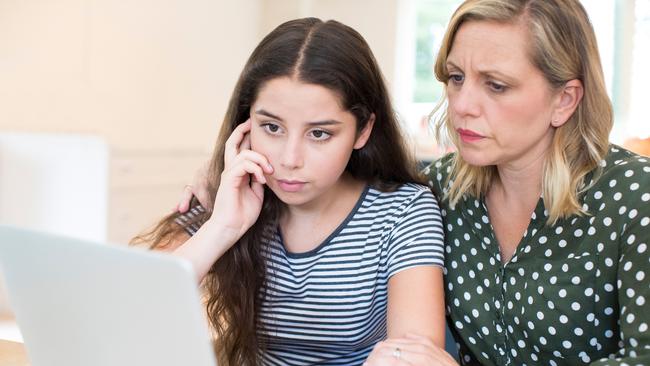Alarming number of teens falling victim to sextortion and cyber-bullying
Criminals are posing as attractive young women to fool Victorian teenagers into sending sexual images before extorting a ransom. Find out how to protect your kids online.

News
Don't miss out on the headlines from News. Followed categories will be added to My News.
Criminals are posing as attractive young women to fool Victorian teenagers into sending sexual pictures and videos.
The organised crime groups then threaten to send the images to their family, friends and work colleagues unless they pay a ransom.
There are about 300 reports of sextortion targeting children each month, the most recent data from the Australian Centre to Counter Child Exploitation reveals.
Sexual extortion reports to eSafety almost tripled from just under 600 reports in the first quarter of 2022 to more than 1700 in the first quarter of last year. The majority of these reports were from young people between 18 and 24 years and 90 per cent were from males.
It comes as new research from headspace’s National Youth Mental Health Survey shows one in five young Victorians have had someone threaten to hurt them online.
More than 13 per cent have experienced catfishing and one in three have had someone post mean or hurtful comments about them online.

The survey of more than 3000 young people also found six in 10 have experienced some form of cyber-bullying in their lifetime.
The most commonly experienced forms of cyber-bullying were being left out of, or removed from, group chats – with two in five having experienced this in their lifetime (43 per cent).
Just under 30 per cent have had someone spread rumours about them online.
Young people experiencing high psychological distress were more likely to experience cyber-bullying (47 per cent), compared to those experiencing low or moderate psychological distress (21 per cent).
eSafety received 2383 reports of cyber-bullying last year, compared to 1700 in 2022, with two-thirds of reports (67 per cent) concerning children aged 12 to 15 years.

National clinical advisor at headspace Rupert Saunders said not all young people will ask for help, which can be challenging for parents.
“But parents are often in a good position to notice changes in behaviour, mood and general wellbeing,” he said.
“It’s important for parents to know that it isn’t their young person’s fault, and to listen without judgement if their young person comes to them for help.
“Having open and honest conversations about safe ways to use social media and what to do if something doesn’t feel right can also be helpful to ensure young people are aware of the risks and feel supported to speak up.”
Senior clinical advisor at headspace Jessie Downey said there are major barriers to young people seeking help after an experience of sextortion, including feelings of embarrassment or shame and fear of backlash from others.
“Given this can be a really frightening and distressing experience for young people, it is important to get support if you feel you’re not coping,” they said.
“If you don’t feel ready to talk to somebody you know, there are lots of free, confidential support services that can help.”

Warning signs of sextortion
• Something doesn’t feel quite right – If their online profile doesn’t match what you see and hear, or you have a bad gut feeling
• You’re feeling pressured – if they keep asking you to do something you’re not comfortable doing
• They rush you – if you’re being rushed to say or do things you’re not ready for, or if the conversation gets personal very quickly
• They make excuses – avoiding video calls or phone conversations is a sign that the person does not match their profile
What should I do if I’m being blackmailed?
1. Collect evidence
Save a record of:
• All contact from the blackmailer – their demands and threats
• How they contacted you – the URL (web address) of where the blackmailer sent you a threat or their usernames on online platforms
• When they contacted you – dates and times
• Details about the blackmailer – their bank account or phone number
2. Report sextortion
• If you’re under 18, report it to the Australian Centre to Counter Child Exploitation
• If you’re 18 years or older, report it to any platforms or services where the blackmailer contacted you. If your intimate image or video is shared, or if the platform doesn’t help, report it to eSafety
3. Stop further contact, tighten security and prevent sharing
• After you have collected evidence, block the blackmailer and ask your friends to do the same
• You can temporarily deactivate your accounts to prevent the blackmailer from harassing you (but don’t delete the accounts, as you may lose evidence that way)
• Review the privacy and security settings of your accounts to limit who can contact you. If you’ve been scammed, change the passwords for your social media and other online accounts.



